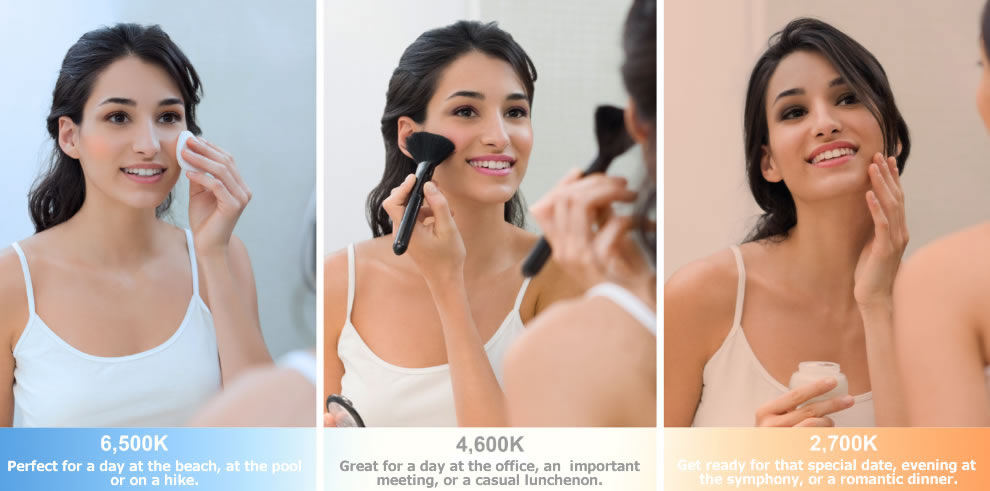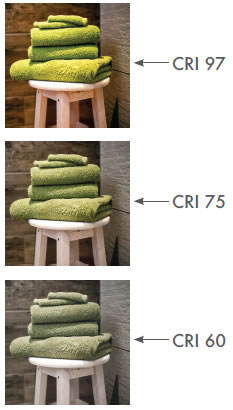All You Wanted to Know... and More
All orders over $49 ship FREE*.
As you browse through our products, notice the shipping time immediately above the "Add to Cart" buttons, similar to the two examples below.

- A licensed electrician should install your hardwired mirror in compliance with all local codes
- It is very important for the makeup mirror to be physically present, and installation should occur in the presence of the most frequent user of the mirror. This is to ensure the mirror is mounted at the correct and most convenient height.
- Install a 4" octagon box on a GFCI line or on a line where a GFCI outlet is installed, or both. The box should be flush with the mounting surface at a height determined by the most frequent user. Although the mirror doesn't weigh 15 lbs., the box should be capable of supporting 15 lbs. The reason for this is that the mirror might weight 6 or 7 lbs, and it may be on an arm as long as 20". Also, be aware that the center of the mirror is usually 1/2" to 6" higher than the mounting-plate center. All of our hardwired makeup mirrors have the on/off switch located within the mirror base, mirror mounting plate, or mirror housing. No separate switch installation necessary. Also note that each of our single and double arm wall mirrors tilt vertically and swing horizontally.
-
Polished Chrome:
- Cool, bluish-silver tone.
- Very high reflectivity - mirror-like.
- Feels modern, sleek, and slightly "industrial".
- Resists tarnish, but shows fingerprints and water spots easily; wipes clean.
- Great for contemporary bathroom fixtures and minimalist designs.
-
Polished Nickel:
- Warm, golden-silver tone.
- Shiny but with a softer, warmer glow when compared with chrome.
- Slightly deeper color due to the the underlying nickel layer. Looks richer and more traditional.
- Feels elegant, timeless, and slightly vintage.
- Can develop subtle patina over time. Easier to hid finger prints compared with chrome.
- Best for transition or classic interiors and high-end bathrooms.

The color temperature of lighti s measured in degrees Kelvin ("k"). The higher the color temperature, up to about 6,500° k the closer the light is to pure white. On a sunny day at noon the light has a color temperature of about 5,500° k. On a very bright cloud-covered day the light is whiter and the light registers a color temperature of about 6,500° k. "Regular" incandescent light bulbs have a color temperature of about 2,700° k.
The color temperature of the lighting in your environment may affect the way people see you in various situations. It's best, therefore, to choose a makeup mirror with lights that has a color temperature to approximate your most frequent environment.
Most of our LED mirrors have their color temperature specified. And some makeup mirrors and bathroom mirrors have adjustable or switchable color temperatures. For products where color temperature is not specified a reasonable guide is this: For incandescent bulbs, a color temperature of around 3,000° k is normal. Fluorescents are barely used any more, and LEDs with no color temperature specification usually have color temperatures around 4,000° k. The three photos below can serve as a guide.

If you're planning for an outdoor day, a higher color temperature is better - 5,500° k up to 6,500° k.
For commercial environment lighting conditions, color temperatures around 4,000° to 4,600° k provide a reasonable match.
For evenings on the town, 2,700°k to 3,500° k is best.
In order to magnify, magnifying mirrors must be distorted. To a greater or lesser degree, all magnification-mirrors distort the image. There is one exception - explained below*. But all is not lost. Better magnifying mirrors minimize the amount of distortion to acceptable or even unnoticeable levels.
There are two principal reasons for distortion. The most important reason is that mirrors magnify by having a concave surface. Without the concavity, there can be no magnification in the reflected image. The more concave the surface of the mirror, the greater is the magnification, and the greater the bend in the glass, the greater the distortion. The saving grace is that at the center portion of the mirror, at any magnification level, there is the least amount of distortion. And in a larger mirror, the size of the center area is relatively larger, thereby creating a larger area where the amount of distortion is least, often minimal or at least not noticeable. This is the most significant reason that a larger mirror is preferable.
The quality of the mirror glass itself is a contributing factor to distortion. A cheap, poorly made magnifying mirror with even slight irregularities in the curvature of the glass will cause similar irregularities in magnification, thereby causing distortion in the reflected image. For that reason it's best to stick with high quality products.
*There is an exception to the distortion issue: A magnifying mirror made with a ground glass lens fronting a flat mirror can be free from distortion. The mirror must be one of top quality and the lens must be of (expensive) optical glass carefully ground to exacting tolerances. Think of it as a telescope lens that's 7" in diameter. If a mirror of this type can be found at all, the cost can easily reach thousands of dollars.
To Find the magnifying power of your own Makeup Mirror
Using your measuring tape, follow these steps:
- Stand far enough from the mirror so that the image you see is upside-down.
- Move around until the reflection of your eye is at the center of the mirror.
- Slowly come closer to the mirror, all the while keeping your eye at the center. It may take a little practice.
- When the image of your eye flips right-side-up and becomes clear. Stop moving.
(Only your eye area should be clear, not your entire face.) - Measure the distance from the center of the mirror to your eye.
- Use the chart below to find the magnification of your mirror.
| Distance to Eye | Magnification |
|---|---|
| 14" | 3x |
| 12" | 5x |
| 10" | 7x |
| 7.5" | 8x |
| 4.2" | 10x |
| 1.8" | 15x |
But it will give you a good approximation of the magnification power of your mirror.

CRI (Color Rendering Index)
Should you care? Yes! And higher is better!
CRI or Color rendering index indicates the ability of a light source to display the colors of various objects faithfully when compared the a natural light source. Light sources such as makeup mirrors or bathroom mirrors with high CRI values are desirable in color-sensitive applications such as makeup application, neonatal care, art restoration and more. Generally a CRI closest to 100, the highest value possible, the truer the color and the more pleasing to the eye.
The highest possible CRI value of 100 is frequently achieved by incandescent or "regular" light bulbs. The most frequently used type of fluorescent bulbs, "cool white", have a CRI of around 50 to 60, although some high-end special use multi-phosphor fluorescents can go up to 98. LEDs typically have an a CRI around 80-85, and better (more expensive) LEDs can have CRIs of 90 and higher.
Our LED Makeup Mirrors, LED Bathroom Mirrors, and LED Medicine Cabinets have CRIs of at least 90 and most have CRIs even higher.
Returns
Within 30 days in most cases, we will send you a return label, no questions asked. We do ask that tell us if the product is defective in some way. This is a general statement that applies to most cases. There are some exceptions - summarized below.
Ineligible for return
1. Custom made products such as Miroir Brot makeup mirrors, Electric Mirror products, and a few others are ineligible for return. Every custom made product has an indication describing the fact they it is custom made, on the page from which the item is selected..
2. Hardwired mirrors that have been electrically connected. As soon as it's connected, the mirror is considered used and becomes ineligible for return.
One more item - a Restocking FEE
We have a single product that has a restocking fee. It is a 15x mirror. It has a restocking fee of $25.00 - the only restocking fee for any product we carry.
See our Complete Refund Policy.
Friendly and Knowledgeable Help
We are available from 8 AM to 6 PM Mountain Time, business days.
Use our Contact Form
email: service@ReflectPerfection.com
Phone: 866-799-9888 press 1 for Customer Service
